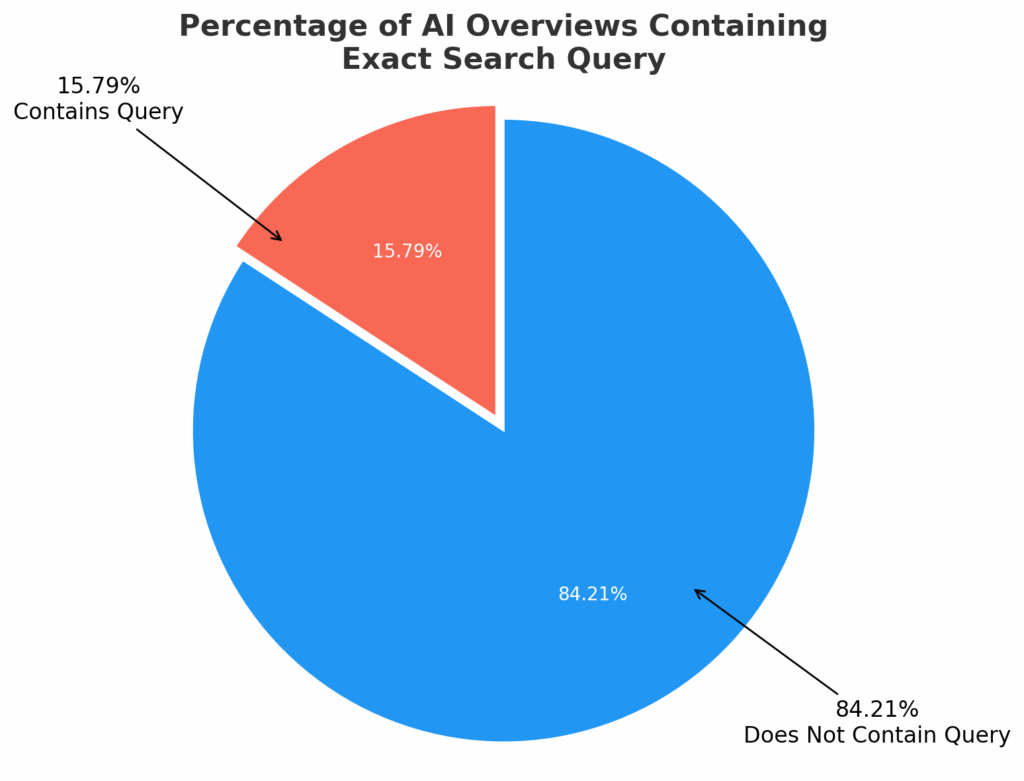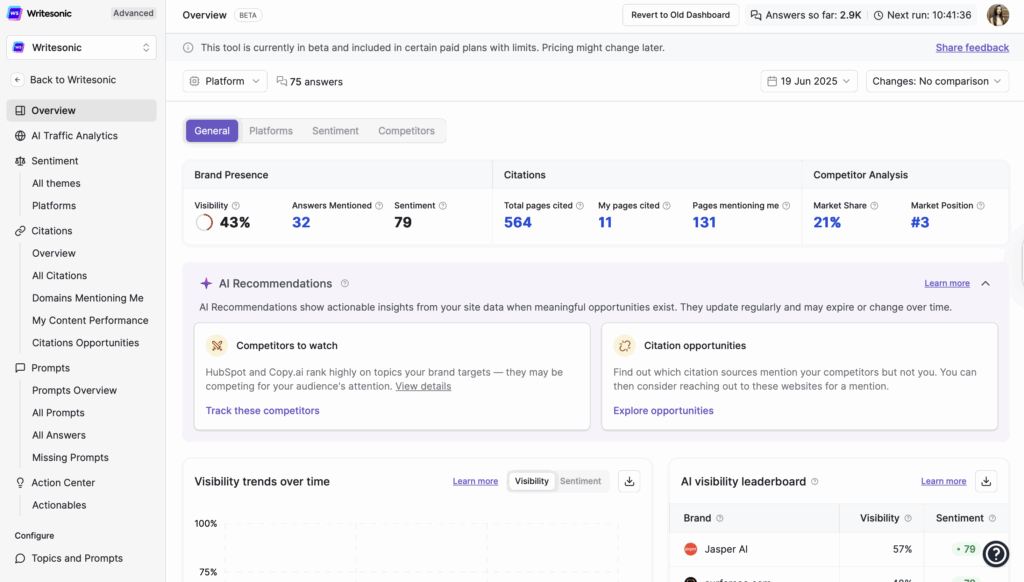Consumer search habits in 2025 look very different from what they did just a few years ago. With platforms like ChatGPT, Perplexity, and Google’s AI Overviews now part of everyday search behavior, people are asking longer, more conversational questions—and receiving answers without needing to click through different blue links.
This blog breaks down the data behind these shifts, what they mean for businesses, and how search visibility is changing across platforms.
Key takeaways:
- 40% of users actively use AI in search, with 80% relying on AI-written answers for at least 40% of their queries.
- Search behavior has shifted from keywords to natural conversation, and AI Overviews are triggered more often by longer, question-based queries.
- Gen Z is using Google less, turning to TikTok, Instagram, and ChatGPT for product and information discovery.
- Traditional SEO alone isn’t enough—Generative Engine Optimization (GEO) is key for staying visible in AI-generated responses.
The current AI search ecosystem
AI is no longer a layer on top of traditional search; it’s becoming the default experience, changing the way we discover information and visibility for brands.
Since late 2022, large language models (LLMs) have fundamentally changed how people interact with search engines. Instead of scanning a list of links, users now receive complete answers directly within AI search engines like AI Overviews or ChatGPT.
This shift is backed by massive adoption:
- ChatGPT reached one million users in just five days, and its subsequent growth to 100 million users two months after launch made it the second-fastest-growing consumer application in history, with over 400 million monthly active users today.
- Google AI Overviews now reach over 1 billion users across more than 100 countries.
- Perplexity AI processed 780 million queries in May 2025 and attracted 129 million visits that month, and over 20% month-over-month growth, underlining how quickly users are embracing conversational, citation-friendly search.
What ties them together is this: they all generate answers, not lists.
Keyword-matching has taken a backseat to context, meaning, and real-time synthesis. Users now receive direct answers and recommendations for detailed search queries, rather than just a list of blue links.
As generative AI becomes the default interface, people are changing not just where they search, but how they search, what they expect from results, and whether they even click through.
How AI search is changing consumer search habits
Search engines used to send people to websites. Now, they directly provide summarized answers. That shift has changed how people search, what they expect from results, and whether they even click through.
Here’s what’s happening and how AI is changing consumer search habits as per the latest data:
1. People are using AI to skip the click
Data from Bain & Company shows more than 80% of consumers report relying on AI-generated results for at least 40% of their searches. In other words, AI isn’t just helping them search—it’s often doing the whole job.
This change in consumer search habits is reflected in traffic, as the same data shows a 15–25% drop in organic clicks when AI-generated summaries are present, particularly for informational queries such as “how to clean white sneakers” or “best laptops under $1,000.”
Even among users who are still skeptical about AI, about 50% say their questions are answered directly on the results page, so they don’t need to keep browsing.
For marketing and SEO teams, this means optimizing content for AI search should be your new priority. With more users relying on AI-generated search results, getting cited by AI is what matters the most.
2. Query patterns are getting longer and more human
People aren’t typing short keyword phrases anymore. AI search tools like ChatGPT and Google’s Overviews respond better to full questions and detailed prompts. As a result:
- Searches with 4 or more words trigger Google AI Overviews 60% of the time.
- According to our data analysis from our GEO tool, AI Overviews for question-based keywords account for approximately 20.09% of the total, which is equivalent to 273.93 words.
That shift isn’t just happening in search boxes. People are starting to treat AI tools like assistants, asking longer, multi-step questions like:
“How do I pick a beginner-friendly DSLR camera under $800, and what accessories do I need to get started?”
Searches like this used to require five or six separate queries. AI now handles them all in one go.
💡Pro tip: For content teams, this means traditional keyword research is no longer sufficient if you want to target the right search intent for visibility. Targeting long-tail and informational queries related to your subject matter will help you rank in AI Overviews.
The key is to prioritize context over keywords.
3. Shift in query patterns
Searches are no longer keyword stubs—they’re full questions, and often complex ones.
Over the past 12 months, longer queries have grown faster than any other segment. Searches containing 5+ words are now growing 1.5x faster than short ones, and those with 8+ words are increasingly likely to trigger AI Overviews.
Instead of typing “men’s running shoes,” users are more likely to ask:
“What’s the best men’s running shoe for high arches and daily walking?”
The reason? AI tools understand natural language better than older search engines. Users no longer have to guess what keywords to include—they just ask the full question. As a result, Google no longer relies on keyword-matching to identify the best search results for queries.

As per data from Writesonic’s GEO tool, which tracks how often AI-generated answers appear on Google and what content they contain.
We found that out of every 100 AI Overview results that Google shows, only about 16 actually include the searcher’s exact phrasing. The other 84 generate answers using different words, even though they’re still intended to answer the original question.
This happens because Google AI Overviews, or AI search results in general, aren’t designed to repeat the query verbatim. Instead, they synthesize information from multiple sources and rewrite it based on:
This shift is especially visible in how people plan multi-step actions.
For example, someone might ask:
“Good day trip ideas from Dallas with kids—and ice cream spots nearby?”
That kind of question wouldn’t have worked in the past. You’d have to run multiple searches, open tabs, compare lists, and read reviews. AI compresses all of that into a single answer.
4. 61% of users still default to Google, but Gen Z is shifting
Google is still the most-used search engine, but its dominance is slipping, especially among younger users.
As of early 2025:
- 61% of Gen Z still use Google regularly, but that’s a noticeable drop from previous generations.
- 67% use Instagram to search for products, reviews, or local recommendations.
- 62% use TikTok for search-related activity—especially how-tos, product comparisons, and “things to do” queries.
Among Gen Z users, 53% say they go to TikTok, Reddit, or YouTube before searching on Google when looking for something. These platforms are faster, more visual, and feel more “real” to younger audiences, especially for lifestyle, shopping, and advice-driven queries.
What’s behind the shift?
- Social platforms are more visual and conversational, matching how Gen Z prefers to consume content.
- AI tools like ChatGPT provide direct answers without ad clutter or SEO-optimized fluff.
- Trust patterns are changing—users now prefer peer-driven content, summaries, or creator reviews over generic listicles.
For marketers and content teams, this shift means you can’t just optimize for Google anymore. You need to understand where your audience actually starts their search, and tailor your content for those formats, styles, and expectations.
5. 42% of people say Google Search is becoming less useful
A recent survey confirms what many have been noticing: almost half of users feel Google is falling short. According to Search Engine Land, 42% of respondents said Google Search is becoming less useful.
Over 50% now rely more on communities—forums, social platforms, or direct recommendations—instead of a traditional search engine.
Why search preferences are shifting:
- AI-generated summaries reduce the need to click. Users get a good answer upfront—or no answer at all.
- Result formats are changing. Pages are filled with ads, carousels, or AI Overviews, making it harder to find basic links.
- Users want authenticity. Forums, Reddit, and TikTok offer peer‑driven content that feels more trustworthy than corporate SEO.
What this means for brands:
If nearly half of your audience believes Google is losing value, it’s time to rethink where and how you’re visible:
- Don’t rely solely on traditional SERPs.
- Invest in presence on community platforms and social networks where users are turning instead.
- Optimize for AI citation, not only ranking: build content that’s easily extractable and answer-ready.
💡Learn more about: Will ChatGPT Replace Google? Here’s Our Data-Driven Analysis
6. 20% of users start local searches on Google and Apple Maps
Not all search starts in a browser. For local intent, a growing number of users skip traditional search entirely and head straight to maps.
Recent data shows:
- 15% of consumers start their local search on Google Maps.
- 45% still start with Google Search, but the gap is closing.
- Combined, Google Maps, Apple Maps, and Bing Maps now account for over 20% of all local search entry points.
That’s a major shift, especially for service businesses, restaurants, clinics, and retail locations.
Why map-based search is growing:
- Users want quick, visual answers—like open hours, ratings, and directions.
- Map apps support filters that matter in the moment: “open now,” “kid-friendly,” “wheelchair accessible”.
- On mobile, map apps are faster than browsers for checking nearby options.
And Google has brought AI into this space too. Its Generative AI in Maps now analyzes over 250 million business locations and 300M+ user contributions to generate personalized suggestions, like:
“Romantic restaurants near me with live music and outdoor seating”
You’ll get a carousel of places, review highlights, photos, and direct actions like “book a table” or “start navigation.”
What this means for local businesses:
To stay visible in these AI-powered map experiences, you need to optimize for local SEO by:
- Keeping business listings accurate and complete across Google, Apple, and Bing.
- Regularly update opening hours, menus, services, and photos.
- Encourage authentic reviews, since AI summaries often pull directly from user feedback.
- Monitor for spam edits or fake listings (Google’s Gemini AI flagged and removed 240M+ bad reviews and 12M fake profiles in 2024 alone).
AI search is no longer just about ranking for “near me” queries. It’s about owning your presence where people are already looking—even if that’s a pin on a map, not a page on a website.
7. 43% of consumers use AI daily, and 75% use new tools more now than a year ago
AI isn’t just experimental — it’s becoming routine.
A recent report reveals that 43% of consumers use AI search tools like ChatGPT or Gemini daily, and 75% report using new search tools more frequently today than they did just a year ago. That means these tools aren’t niche — they’re becoming habitual.
Why it matters:
- If you’re not prioritizing techniques like answer engine optimization, you’re invisible to nearly half of active searchers.
- Consistency across platforms (ChatGPT, Gemini, Google Overviews) becomes critical — users are surface-checking answers across multiple sources.
- 48% of users cross-check AI answers across platforms
Even with AI becoming a first stop, trust isn’t automatic.
According to a Yext survey, 48% of users always verify answers across multiple platforms, comparing ChatGPT, Google AI Overviews, Reddit, and others before accepting information.
Only 10% trust the first AI-generated result without question. Why this matters for marketing and PR teams:
- Brand info needs consistency—not just clarity—across different search tools.
- Mismatched snippets or tone can erode trust and increase drop-off.
- Optimizing content for AI visibility means being accurate everywhere consumers look.
8. 67% of U.S. consumers make a purchase through social media at least once a month
Search isn’t just happening in Google anymore—it’s happening in feeds.
A 2025 GRIN survey reveals that 67% of U.S. consumers report making a purchase through social media at least once a month—a clear indication that buying while scrolling is a mainstream behavior.
For Gen Z, shopping inside Instagram or TikTok is so common that 61% prefer completing purchases without leaving the app, and 57% say they use creator promo codes to finalize their decisions.
Why this matters:
- Consumers now expect instant buy buttons and interactive experiences in feeds.
- AI-powered recommendations or influencer-triggered suggestions work in real time.
- Brands need to optimize for AI-friendly formats—visual content, reviews, discount codes—not just search results.
10. 83% of consumers use Google for local business reviews
Even in an AI-powered search era, reviews remain essential, and Google is still king.
BrightLocal’s 2025 Local Consumer Review Survey finds that 83% of U.S. consumers use Google to find local business reviews, making it the top review source. Another 74% consult at least two platforms, and 34% look at three or more before making decisions.
Why this matters:
- AI-generated answers often include review snippets, so if your brand lacks strong, authentic reviews, it may not get featured.
- Google reviews are not just for rankings—they shape AI-driven summaries and local AI Overviews.
- Consumers are still actively researching; AI may summarize, but reviews and local context confirm trust and prompt action.
💡Learn more about: Will AI Replace Search Engines? What Marketers Must Know!
Impact of AI on search visibility and SEO
AI-generated search is cutting into traditional traffic—and fast.
According to Gartner, organic traffic could drop by over 50% by 2026 as AI tools answer more questions without sending users to websites. Informational searches are already seeing sharp declines in click-through rates, especially for top-of-funnel content like listicles, how-tos, and product roundups.
If your strategy still relies on ranking #1 in Google, you’re likely seeing that erosion already. With AI impacting SEO, here’s what’s changed for website visibility:
- AI Overviews, ChatGPT, and Perplexity don’t list 10 links—they generate a single, consolidated answer.
- Those answers are often drawn from 1–3 sources, or sometimes none at all (if the LLM has enough prior context).
- Even when links are shown, they’re secondary—most users don’t click unless the summary is incomplete or unclear.
1. Traditional SEO isn’t enough anymore
Ranking on Google doesn’t guarantee you’ll be cited in an AI-generated response. That’s because LLMs choose sources based on clarity, structure, and semantic relevance, not just backlinks or keyword density.
Even sites with top rankings might be ignored if the content is:
- Too broad or unstructured
- Not directly answering the query
- Lacking topical authority or contextual cues that help AI understand what it’s about
This shift is most visible in non-branded, info-heavy queries, where AI is confident enough to generate summaries without pointing users anywhere else.
2. Generative Engine Optimization (GEO) is the next frontier
GEO (Generative Engine Optimization) is the process of optimizing content so that LLMs and AI search can easily find, extract, and reference it in generated answers. It goes beyond keywords and focuses on:
- Clear heading hierarchies
- Conversational formatting
- Semantic clarity and direct answers
- Structuring content so it can be cited with minimal ambiguity
It’s not about ranking—it’s about being the source AI tools choose to summarize.
Tools like Writesonic GEO (more on that in the next section) are helping marketers track how often they’re cited in ChatGPT, Google Overviews, and other AI interfaces. For brands, this is becoming just as important as Google Analytics.
If your content isn’t being picked up by AI, it doesn’t matter how well it ranks in search results. It’s invisible to a growing share of users.
How Writesonic GEO helps boost AI search visibility
Traditional SEO tools weren’t built for AI-first search. That’s where Writesonic GEO comes in.
It’s designed to help you track and improve how often your brand appears in AI-generated answers across platforms like ChatGPT, Google AI Overviews, Bing Copilot, and Perplexity.

With GEO by Writesonic, you can:
- See which AI search engines are mentioning your brand (and which aren’t)
- Benchmark against competitors across thousands of prompts
- Get optimization suggestions to improve AI visibility and content structure
- Track AI crawler traffic—visits from bots that don’t show up in Google Analytics
- Monitor which prompts are citing your brand, and which are not.
Whether you’re building top-of-funnel content, FAQs, or product explainers, GEO gives you the insights you need to show up where users are actually searching, not just where they used to.
Want to see how your brand appears in AI search today? Book a demo and get a visibility audit from the team.


















